
(a)
Interpretation:
The complete, detailed mechanism and the major organic product for the given reaction is to be drawn.
Concept introduction:
When
Answer to Problem 18.68P
The complete, detailed mechanism and the major organic product for the given reaction is as shown below:
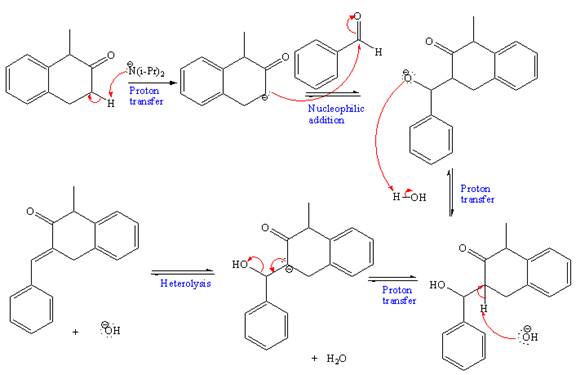
Explanation of Solution
The given reaction is as shown below:
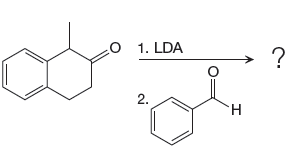
The given reaction is a crossed aldol condensation as the nucleophilic species is generated from a different ketone than the one that is attacked. Firstly, the given ketone is treated with LDA to produce
The complete, detailed mechanism and the major organic product for the given reaction is as shown below:
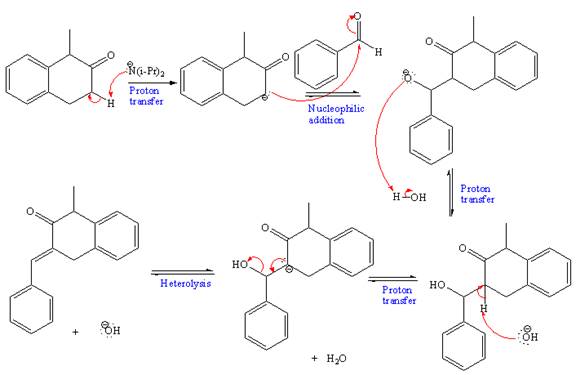
The complete, detailed mechanism and the major organic product for given reaction is drawn by crossed aldol reaction followed by dehydration of
(b)
Interpretation:
The complete, detailed mechanism and the major organic product for given reaction is to be drawn.
Concept introduction:
When ketone is treated with sodium hydroxide, the product
Answer to Problem 18.68P
The complete, detailed mechanism and the major organic product for given reaction is as shown below:
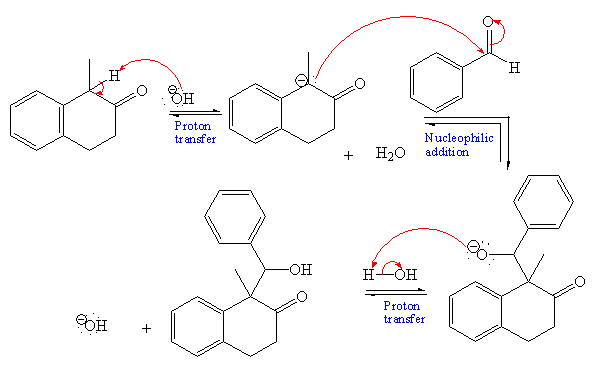
Explanation of Solution
The given reaction is as shown below:
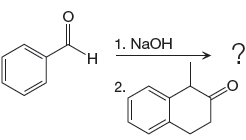
The given reaction is a crossed aldol reaction. In Step 1,

The complete, detailed mechanism and the major organic product for given reaction is drawn on the basis of crossed aldol reaction mechanism.
(c)
Interpretation:
The complete, detailed mechanism and the major organic product for given reaction is to be drawn.
Concept introduction:
When aldehyde is treated with sodium hydroxide, the product
Answer to Problem 18.68P
The complete, detailed mechanism and the major organic product for given reaction is as shown below:
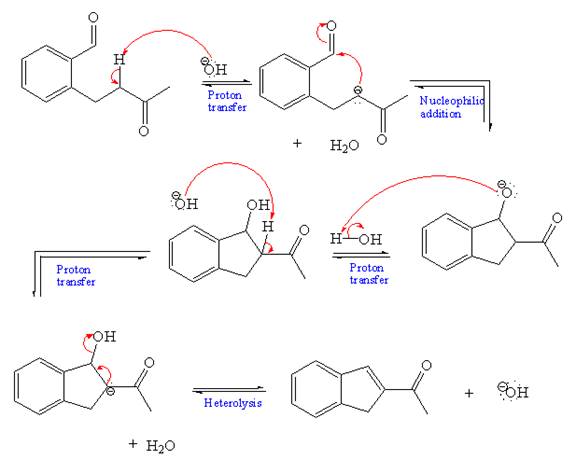
Explanation of Solution
The given reaction is
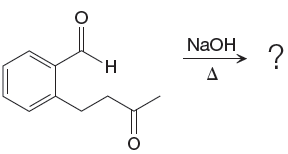
The given reaction is intramolecular aldol condensation reaction as the sodium hydroxide and heat is given. The given aldehyde is treated with sodium hydroxide, to produce
The complete, detailed mechanism and the major organic product for the given reaction is as shown below:

The complete, detailed mechanism and the major organic product for given reaction is drawn on the basis of intramolecular aldol condensation reaction.
(d)
Interpretation:
The complete, detailed mechanism and the major organic product for given reaction is to be drawn.
Concept introduction:
When ketone is treated with strong base like LDA, the product enolate anion is formed. In Step 1, LDA deprotonates the
Answer to Problem 18.68P
The complete, detailed mechanism and the major organic product for given reaction is as shown below,
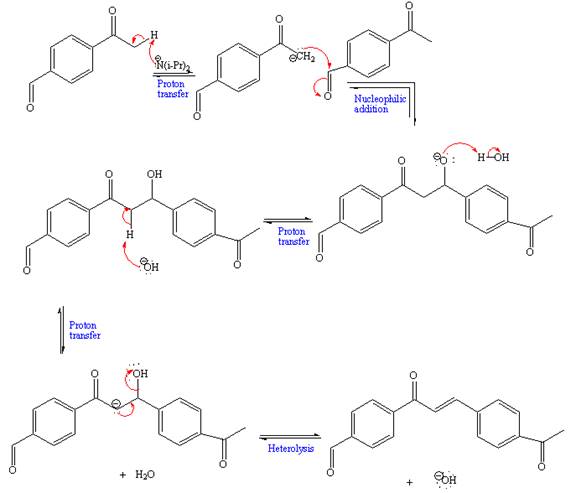
Explanation of Solution
The given reaction is
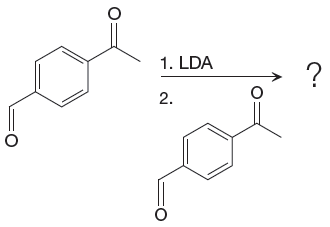
Firstly, the given ketone is treated with LDA, to produce
The complete, detailed mechanism and the major organic product for given reaction is as shown below,
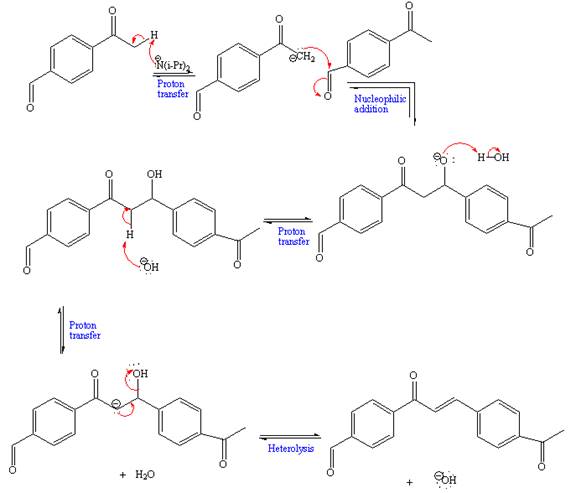
The complete, detailed mechanism and the major organic product for given reaction is drawn by aldol addition reaction followed by dehydration of
Want to see more full solutions like this?
Chapter 18 Solutions
EBK ORGANIC CHEMISTRY: PRINCIPLES AND M
- Part 1. Draw monomer units of the following products and draw their reaction mechanism 1) Bakelite like polymer Using: Resorcinol + NaOH + Formalin 2) Polyester fiber Using a) pthalic anhydride + anhydrous sodium acetate + ethylene glycol B)pthalic anhydride + anhydrous sodium acetate + glycerol 3) Temporary cross-linked polymer Using: 4% polyvinyl alcohol+ methyl red + 4% sodium boratearrow_forwardUsing the table of Reactants and Products provided provide the correct letter that corresponds with the Carboxylic acid that is formed in the reaction below. 6 M NaOH Acid-workup WRITE THE CORRECT LETTER ONLY DO NOT WRITE EXTRA WORDS OR PHRASES A) Pool of Reagents for Part B CI B) OH C) E) CI J) racemic F) K) OH N) OH P) G) OH D) HO H) L) M) HO Q) R) CI Aarrow_forwardIn the table below, the exact chemical structures for Methyl salicylate can be represented by the letter WRITE THE CORRECT LETTER ONLY DO NOT WRITE EXTRA WORDS OR PHRASES CI B) A) E) Cl racemic F) J) CI K) N) OH P) Pool of Reagents for Part B OH OH G) L) OH D) HO H) M) HO Q) R) CIarrow_forward
- Draw the stepwise mechanism for the reactionsarrow_forwardPart I. a) Draw reaction mechanism for the transformations of benzophenone to benzopinacol to benzopinaco lone b) Pinacol (2,3-dimethyl, 1-3-butanediol) on treatment w/ acid gives a mixture of pina colone (3,3-dimethyl-2-butanone) and 2, 3-dimethyl - 1,3-butadiene. Give reasonable mechanism the formation of the products Forarrow_forward3. The explosive decomposition of 2 mole of TNT (2,4,6-trinitrotoluene) is shown below: Assume the C(s) is soot-basically atomic carbon (although it isn't actually atomic carbon in real life). 2 CH3 H NO2 NO2 3N2 (g)+7CO (g) + 5H₂O (g) + 7C (s) H a. Use bond dissociation energies to calculate how much AU is for this reaction in kJ/mol.arrow_forward
- Part I. Draw reaction mechanism for the transformations of benzophenone to benzopinacol to benzopinaco lone and answer the ff: Pinacol (2,3-dimethyl, 1-3-butanediol) on treatment w/ acid gives a mixture of pina colone and (3,3-dimethyl-2-butanone) 2,3-dimethyl-1,3-butadiene. Give reasonable mechanism the formation of the products Forarrow_forwardShow the mechanism for these reactionsarrow_forwardDraw the stepwise mechanismarrow_forward
 ChemistryChemistryISBN:9781305957404Author:Steven S. Zumdahl, Susan A. Zumdahl, Donald J. DeCostePublisher:Cengage Learning
ChemistryChemistryISBN:9781305957404Author:Steven S. Zumdahl, Susan A. Zumdahl, Donald J. DeCostePublisher:Cengage Learning ChemistryChemistryISBN:9781259911156Author:Raymond Chang Dr., Jason Overby ProfessorPublisher:McGraw-Hill Education
ChemistryChemistryISBN:9781259911156Author:Raymond Chang Dr., Jason Overby ProfessorPublisher:McGraw-Hill Education Principles of Instrumental AnalysisChemistryISBN:9781305577213Author:Douglas A. Skoog, F. James Holler, Stanley R. CrouchPublisher:Cengage Learning
Principles of Instrumental AnalysisChemistryISBN:9781305577213Author:Douglas A. Skoog, F. James Holler, Stanley R. CrouchPublisher:Cengage Learning Organic ChemistryChemistryISBN:9780078021558Author:Janice Gorzynski Smith Dr.Publisher:McGraw-Hill Education
Organic ChemistryChemistryISBN:9780078021558Author:Janice Gorzynski Smith Dr.Publisher:McGraw-Hill Education Chemistry: Principles and ReactionsChemistryISBN:9781305079373Author:William L. Masterton, Cecile N. HurleyPublisher:Cengage Learning
Chemistry: Principles and ReactionsChemistryISBN:9781305079373Author:William L. Masterton, Cecile N. HurleyPublisher:Cengage Learning Elementary Principles of Chemical Processes, Bind...ChemistryISBN:9781118431221Author:Richard M. Felder, Ronald W. Rousseau, Lisa G. BullardPublisher:WILEY
Elementary Principles of Chemical Processes, Bind...ChemistryISBN:9781118431221Author:Richard M. Felder, Ronald W. Rousseau, Lisa G. BullardPublisher:WILEY





